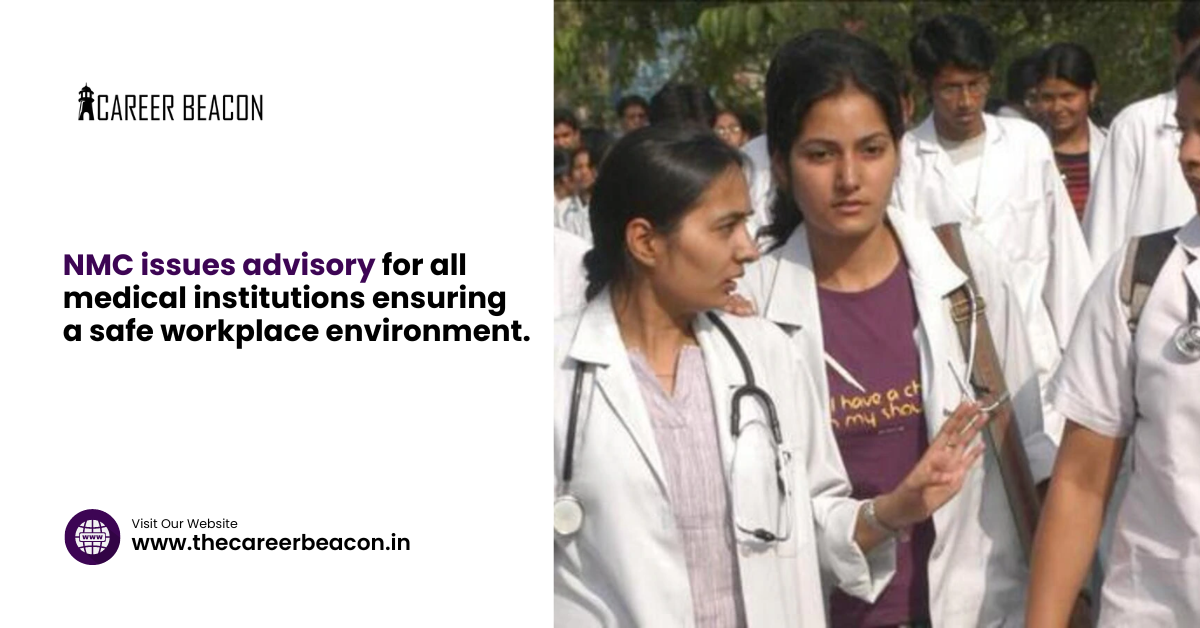
NMC issues advisory for all medical institutions ensuring a safe workplace environment.
Recently, a critical advisory has been passed out by the National Medical Commission (NMC) to all medical institutions concerning ensuring a safe workplace. This directive has come at a time when the presence of a secure, empowering workplace free from harassment is becoming a necessity not only for the healthcare workforce’s health and safety but also for their progress and advancement in the sphere of patient care. In this blog, we will discuss why a safe workplace is important to career advancement and how it influences career selection and improves the efficiency of the medical occupation.
The Role of Risk Management in Medical Organizations
The welfare of a workplace is an important aspect of the organisation’s success, especially in healthcare facilities. People who work in the healthcare sector are under pressure; they have long working hours, and many times they are working with people with emotional issues. In such a setting, one can note the high risk of sexual harassment, discrimination, and employee burnout. Hence, instead of acting late to the growing cases, the NMC’s advisory comes in handy as an important measure to protect healthcare workers, such that they can exercise their duties without the possibility of being harmed or stressed out.
Therefore, medical institutions need to show the employees respect by ensuring that they have an environment that is safe enough to work in. The need for feeling safe is important as it helps the staff to be mentally and emotionally at ease when attending to their duties, hence improving patient care. Second, it also has a positive effect on the organisational culture, meaning that it creates effective and safe communication practices to prevent problems from escalating and improve solution-seeking.
Impact on Career Development
Hence, career growth in the medical sector is a dynamic and lifelong process. They are dynamic in the sense that they require constant learning or gradual improvement of personal skills as well as the capacity to face new challenges. However, these aspects of career advancements can only develop when the workers embrace safety and protection.
Hence, when safety is deemed important in medical institutions, then they help to set the career development path. Teachers or healthcare workers will teach and attend trainings, workshops, conferences, or other professional development activities if they know they will be embraced. This not only brings about closer association with the respective professions but also raises their performance level and enthusiasm.
Besides, safety at the workplace refers to the condition under which learning and guidance, which is a core aspect of career development, occurs. The managers or supervisors, in this case, senior healthcare professionals, can afford to extend their hand and help out the junior staff or offer to listen to their grievances without preconditions that may lead to the creation of a toxic workplace. This mentoring is crucial in the development of healthcare workers and is vital in assisting these workers in making the right decisions about their career decisions.
Influence on Career Choices
Since work in the medical field encompasses many career choices, the decision-making is based on several factors, such as passion, job security, balance between family and work, and workplace safety. In the advisory of the NMC, there is an emphasis on the safety of medical institutions, as this has far-reaching implications for career decisions among healthcare practitioners.
To many people, the working environment plays the largest role in job selection in a given medical speciality or institution. An ideal workplace should be free from cases of harassment and discrimination; hence, professionals do want to work in an environment that does not compromise their well-being. It also has a positive impact on the institution since it creates a way through which they can be assured of hiring and maintaining qualified employees with the necessary passion to render quality services to the patented.
Similarly, the protection of healthcare employees’ workplaces may help to attract more people to the healthcare field, especially in districts with a lack of qualified personnel. We find that when prospective healthcare workers observe that these institutions have their best interests at heart, more will develop interests in these careers, knowing that their services will be appreciated and their lives valued.
Implementing the NMC’s Advisory: Gentlemen: This memorandum is an attempt to present the following steps for medical institutions:
This means that, according to the advisory made by the NMC, medical institutions are required to take some preventive measures because the medical profession is dangerous. These may include:
Establishing Clear Policies and Procedures: Institutions need to have sound policies regarding workplace harassment, discrimination, and safety. These policies should also be well understood by all the staff and, above all, should be well implemented.
Providing Training and Education: Weekly training sessions that address such issues as workplace safety, sexual harassment, or conflict resolution should be held. These programs should be mandatory for all staff members so that, as a company, the value of a safe workplace is well understood across the board.
Creating Support Systems: Hospitals and other medical organisations should try to provide services for the psychological support of their staff, including EAP, counselling, peer support, etc.
Encouraging Open Communication: There must be an open-door policy at work so that the staff members feel free to voice their concerns without necessarily fearing being punished for reporting the truth. It is also important that institutions should incorporate reporting of issues without the perpetrator knowing that he or she is being reported and that issues reported should be dealt with as soon as possible.
Monitoring and Evaluation: Semi-annual reviews or assessments should be performed on the workplace environment to determine the viability of any concerns and opportunities for change. Supervisory feedback from the staff members should further be encouraged and applied to improve the safety of the workplace.


